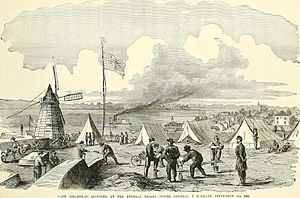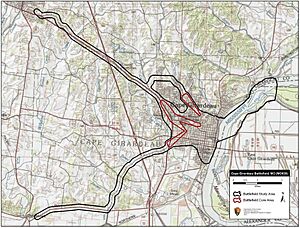Battle of Cape Girardeau facts for kids
Quick facts for kids Battle of Cape Girardeau |
|||||||
|---|---|---|---|---|---|---|---|
| Part of the Trans-Mississippi Theater of the American Civil War |
|||||||
 Cape Girardeau occupied by federal troops |
|||||||
|
|||||||
| Belligerents | |||||||
| Commanders and leaders | |||||||
| John McNeil | John S. Marmaduke | ||||||
| Strength | |||||||
| 4,000 | 5,000 | ||||||
| Casualties and losses | |||||||
| 12 | 325 | ||||||
The Battle of Cape Girardeau was a small but important event during the American Civil War. It happened on April 26, 1863, in Cape Girardeau, Missouri. This conflict was part of a chase. Union General John McNeil was being pursued through Southeast Missouri by Confederate General John S. Marmaduke. Even though it's called a battle, it was more of a military show-off. It marked the end of General Marmaduke's second raid into Missouri.
Contents
Why the Battle of Cape Girardeau Happened
General Marmaduke started his second raid into Missouri on April 18, 1863. He wanted to get supplies for his soldiers. Many of his troops didn't have weapons or horses. Marmaduke hoped to arm and mount them with things captured during the raid. He worried they might leave if left behind.
Marmaduke divided his 5,000 men into two main groups, called columns. Each column had two brigades, which are smaller groups of soldiers. Colonel George W. Carter led one column. Colonel Joseph O. Shelby led the other. Shelby's column included his famous "Shelby's Iron Brigade." Marmaduke's forces had about eight to ten cannons.
The Chase to Cape Girardeau
General Marmaduke told Colonel Carter's column to go to Bloomfield, Missouri. They were supposed to capture the Union soldiers there. These Union troops were led by General John McNeil. If McNeil escaped, the Confederates thought he would head north to Pilot Knob, Missouri. This was the main Union base in the area. So, Marmaduke went with Colonel Shelby's column to Fredericktown, Missouri to stop McNeil.
Shelby's column reached Fredericktown on April 22, 1863. But Carter's column had trouble crossing swamps. They didn't get to Bloomfield until April 23. When Carter arrived, McNeil had already left Bloomfield in ruins two days earlier. McNeil had learned where Marmaduke was. He decided not to go to Pilot Knob. Instead, he fled northeast to the strong defenses of Cape Girardeau. He arrived there on the evening of April 24.
Carter was told not to chase McNeil if he went anywhere but Pilot Knob. But Carter didn't follow orders. He chased McNeil anyway, getting within four miles of Cape Girardeau by April 25. Carter then sent a letter to McNeil. He demanded that the Union soldiers surrender within 30 minutes. Carter signed the letter with the name of Confederate General Sterling Price. He hoped this would scare McNeil. But McNeil felt confident in his defenses and refused to give up. Carter then sent word to General Marmaduke. Marmaduke brought Shelby's column to help Carter's troops at Cape Girardeau.
Cape Girardeau's Strong Forts
In 1861, General Ulysses S. Grant approved building four forts around Cape Girardeau. They were called Forts A, B, C, and D.
- Fort A was on a high point overlooking the Mississippi River. It was meant to stop Confederate gunboats.
- Fort B was on a hill where Southeast Missouri State University is now. It protected the city from attacks on the Perryville and Jackson roads.
- Fort C was near South Ellis Street and Good Hope Street today. It guarded roads from Bloomfield, Gordonville, and Commerce.
- Fort D was also on a river bluff, south of the city. It was the biggest fort and protected the river. It is the only fort still standing today. However, Fort D didn't play a big role in this battle.
What Happened During the Battle
On the night of April 25, General McNeil prepared for the attack. He ordered women and children to leave by steamboat to a safe place. Also that night, two gunboats and a steamer arrived with more Union troops. With the gunboats, McNeil felt safe from attacks from the river. So, he moved cannons from Forts A and D to Forts B and C on the western side of the city. In total, McNeil had about 4,000 men. These included soldiers from Iowa, Wisconsin, Nebraska, and Illinois. Some of these troops might have arrived after the fighting ended.
Shelby's column arrived at Cape Girardeau early on April 26. General Marmaduke's entire force was now on the western edge of the city. They formed a line. Colonel Burbridge's brigade was in the middle. Shelby's was on the left, and Carter's was on the right. Their line stretched from St. Mary's Cemetery in the north to Gordonville Road in the south. The center of their line was on Jackson Road.
The attack started around 10:00 am on April 26. Both sides tried to charge with their cavalry, which are soldiers on horseback. The Union cavalry was pushed back by Shelby's stronger cavalry. The Confederate cavalry faced heavy fire from cannons in Forts B and C. Most of the fighting was cannon fire between the forts and Shelby's Brigade. The battle lasted about four to five hours. It stopped sometime after 2:00 pm when General Marmaduke ordered his troops to pull back.
After the Battle
There are no exact numbers for how many soldiers were killed or hurt. The official reports were often made bigger than the real numbers. It's believed that no more than ten soldiers died on either side. However, some reports claim nearly a hundred were killed and over three hundred were wounded.
After the fighting, General Marmaduke retreated to Jackson, Missouri. Then he led his troops back to Arkansas. This ended his second raid into Missouri. Union forces followed Marmaduke, but they didn't fight again before the Confederates crossed into Arkansas. Colonel Carter was demoted. He was put in charge of a smaller group of soldiers instead of his whole column. This might have been punishment for not following orders at Cape Girardeau.
Neither side had a clear win on the day of the battle. But it was a strategic victory for the Union. It forced the Confederate forces to retreat back to Arkansas. Historian Henry Phillips said that it wasn't a huge battle. But it had the potential to be a very bloody one. The reason it wasn't was because both commanders had reasons not to push the fight further.
Forces Involved
Confederate Troops
General John S. Marmaduke commanded about 5,086 men and 8 cannons. His forces were organized into several brigades.
- Colonel Joseph O. Shelby's brigade included several Missouri Cavalry Regiments and a battery of cannons.
- Colonel Colton Greene's brigade had the 3rd and 8th Missouri Cavalry Regiments, and the 11th Missouri Cavalry Battalion.
- Colonel John Q. Burbridge's brigade included his own Missouri Cavalry Regiment, the 5th Arkansas Cavalry Regiment, and Kitchen's Missouri Cavalry Battalion.
- Colonel George W. Carter's brigade had the 19th and 21st Texas Cavalry Regiments, two Texas Cavalry units, and the 10th Texas Field Battery.


